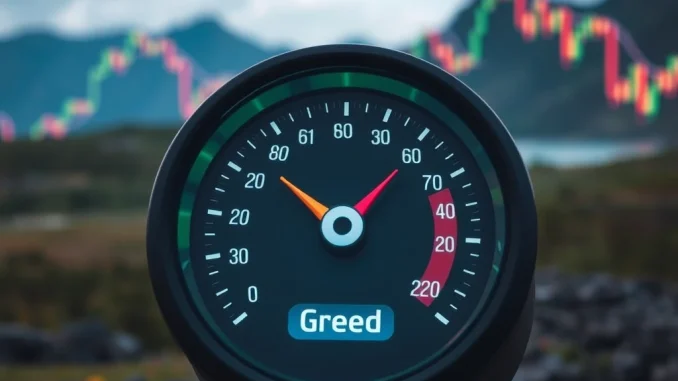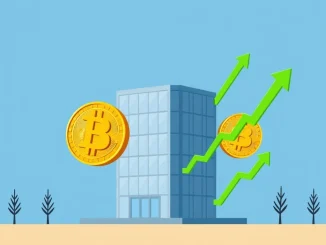
Keeping a pulse on the cryptocurrency market can feel like a rollercoaster. Prices swing, news breaks, and everyone seems to have a different opinion. How do you gauge the overall mood? One popular tool is the Crypto Fear and Greed Index. Recently, this index showed a notable movement, climbing to 67 and holding steady in the ‘Greed’ zone. Let’s break down what this means for the market.
What is the Crypto Fear and Greed Index?
The Fear and Greed Index is a simple yet effective tool designed to measure the prevailing emotions in the crypto market. It operates on the principle that excessive fear can drive prices down, creating a potential buying opportunity, while excessive greed can push prices up unsustainably, potentially leading to a correction.
Provided by software development platform Alternative, the index distills various market factors into a single number between 0 and 100:
- 0-24: Extreme Fear – Suggests investors are overly worried, potentially a buying opportunity.
- 25-49: Fear – Market is apprehensive, but not in a panic state.
- 50-50: Neutral – Sentiment is balanced, neither overwhelmingly fearful nor greedy.
- 51-74: Greed – Investors are becoming optimistic and prices might be getting overvalued.
- 75-100: Extreme Greed – Suggests the market is due for a correction as prices are likely inflated by FOMO (Fear Of Missing Out).
As of May 7th, the index registered 67, an increase of eight points from the previous day, keeping it firmly within the ‘Greed’ territory.
How is the Fear and Greed Index Calculated?
The index isn’t based on a single metric but aggregates data from six different sources, each weighted to contribute to the final score. Understanding these components helps interpret the index’s reading:
| Factor | Weighting | What it Measures |
|---|---|---|
| Volatility | 25% | Measures the current volatility and max drawdown of Bitcoin (BTC) compared to average values. High volatility often signals fear. |
| Market Momentum/Volume | 25% | Analyzes the current market volume and momentum compared to average values. High buying volume in a positive market often signals greed. |
| Social Media | 15% | Scans Twitter for posts related to Bitcoin. Measures the number and speed of posts, as well as the sentiment (positive vs. negative) of specific hashtags. High engagement can signal greed. |
| Surveys | 15% | Polls people weekly on their market sentiment. (Note: This component is currently paused). |
| Bitcoin Dominance | 10% | Measures Bitcoin’s share of the total crypto market cap. Rising BTC dominance can signal fear (money flowing into perceived ‘safer’ BTC) or greed (excitement around BTC). |
| Google Trends | 10% | Analyzes search queries related to Bitcoin. Rising search volume for terms like ‘Bitcoin price manipulation’ or ‘Bitcoin crash’ can signal fear, while searches for ‘buy Bitcoin’ or ‘Bitcoin rally’ can signal greed. |
The combination of these factors provides a comprehensive look at overall Crypto Sentiment.
What Does the ‘Greed’ Zone Mean for the Market?
When the index is in the ‘Greed’ zone (51-74) or ‘Extreme Greed’ zone (75-100), it typically suggests that investors are feeling optimistic and confident. While optimism isn’t inherently bad, excessive greed can lead to irrational behavior, such as buying assets at inflated prices based on FOMO rather than fundamental analysis. This can create a market environment that is ripe for a correction.
A reading of 67, while not in the ‘Extreme Greed’ zone, indicates strong positive sentiment. This level of Crypto Market Sentiment suggests that many participants are feeling bullish and are actively buying or holding onto their assets, expecting further price increases. Historically, prolonged periods of high greed have often preceded market pullbacks.
How Can You Use the Bitcoin Fear and Greed Index?
The Bitcoin Fear and Greed Index (as Bitcoin heavily influences the overall index) is not a direct trading signal but rather a sentiment indicator. Many traders and investors use it as a contrarian tool, following the famous advice from Warren Buffett: “Be fearful when others are greedy, and greedy when others are fearful.”
- When the index is high (Greed/Extreme Greed): This might be a time to be cautious. Consider taking some profits, tightening stop-losses, or refraining from opening new long positions based purely on market euphoria.
- When the index is low (Fear/Extreme Fear): This could signal a potential buying opportunity. While fear can drive prices below their intrinsic value, it’s important to do your own research and not buy solely based on the index reading.
The index provides context to price movements. If prices are rising while the index is in ‘Extreme Fear’, it might indicate a healthy, cautious rally. If prices are skyrocketing while the index is in ‘Extreme Greed’, it could be a sign of an unsustainable bubble forming.
Looking Ahead: What Does 67 Tell Us?
The move to 67 shows that the recent positive price action in the crypto market, particularly in Bitcoin, has boosted investor confidence. The eight-point jump indicates a rapid shift in sentiment, suggesting that more participants are feeling optimistic. While 67 isn’t the peak of ‘Extreme Greed’, it puts the market squarely in a territory where caution is warranted.
Monitoring the index in the coming days will be important. A sustained reading in the ‘Greed’ zone, or a push into ‘Extreme Greed’, could signal that market euphoria is reaching levels where a correction becomes more likely. Conversely, a sudden drop in the index, even if prices remain stable, could indicate underlying fear or uncertainty starting to creep back in.
Conclusion
The Crypto Fear and Greed Index rising to 67 and staying in the ‘Greed’ zone highlights the current positive sentiment in the market. While this reflects recent gains and optimism, it also serves as a reminder to approach the market with a degree of caution. Sentiment is just one piece of the puzzle; combining this insight with technical analysis, fundamental research, and sound risk management is crucial for navigating the volatile world of cryptocurrency.



